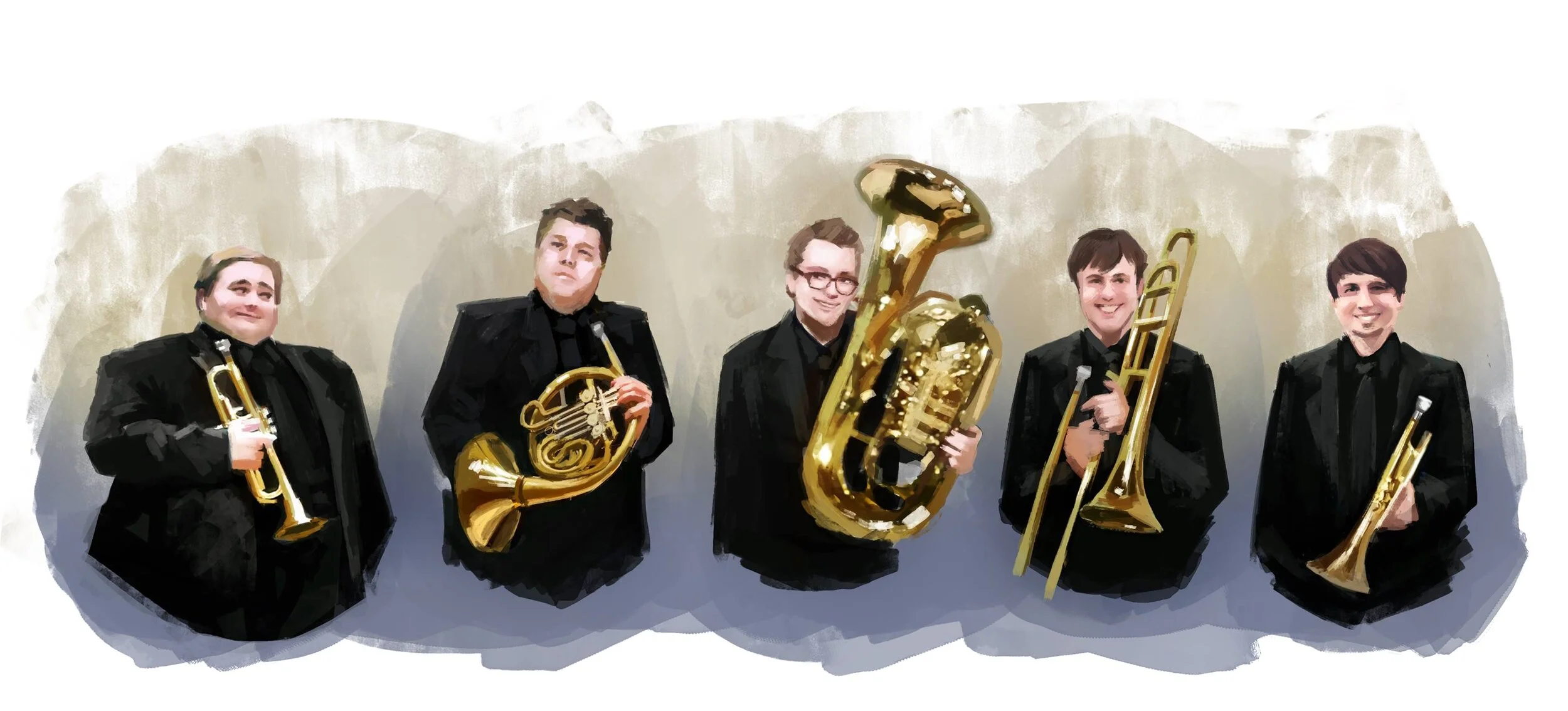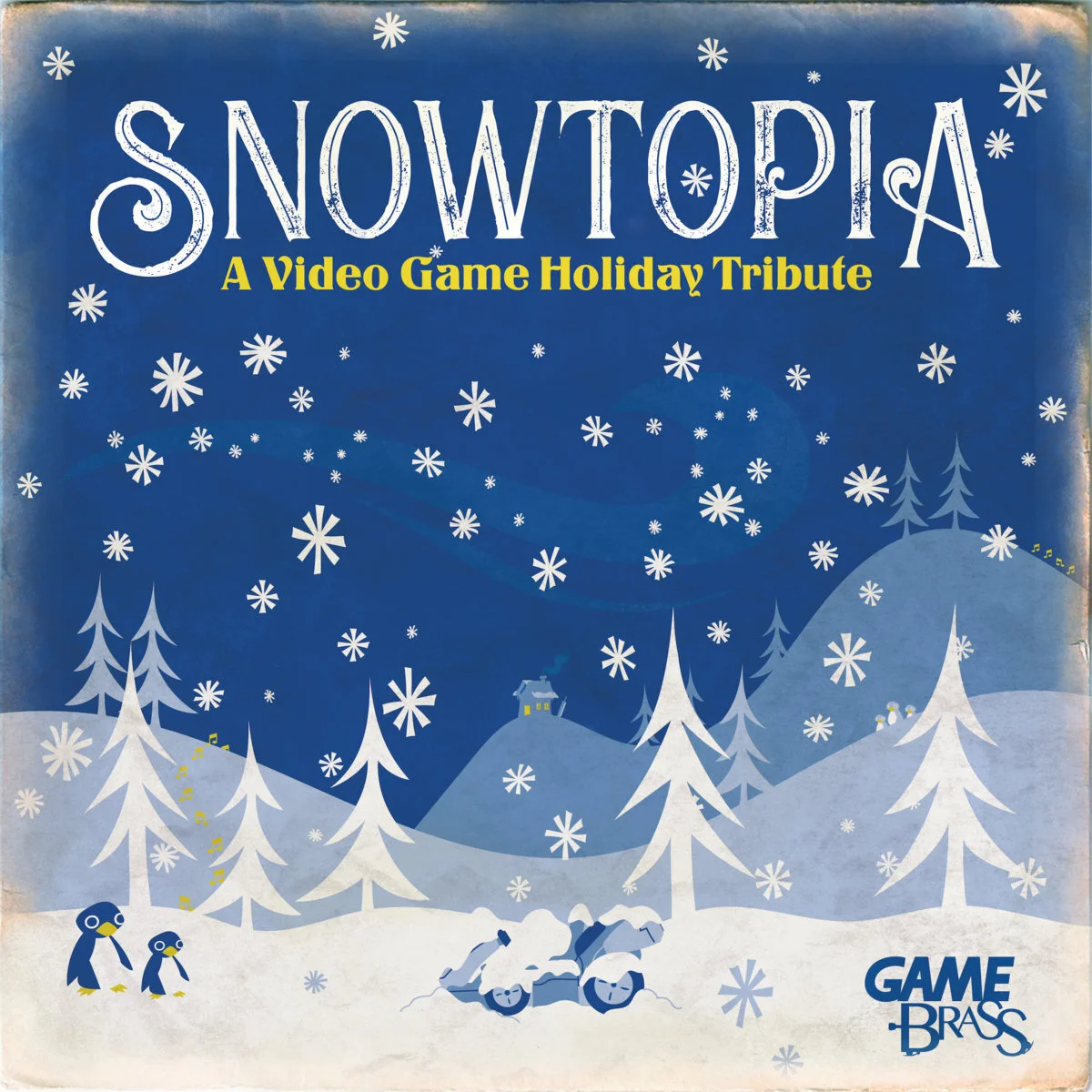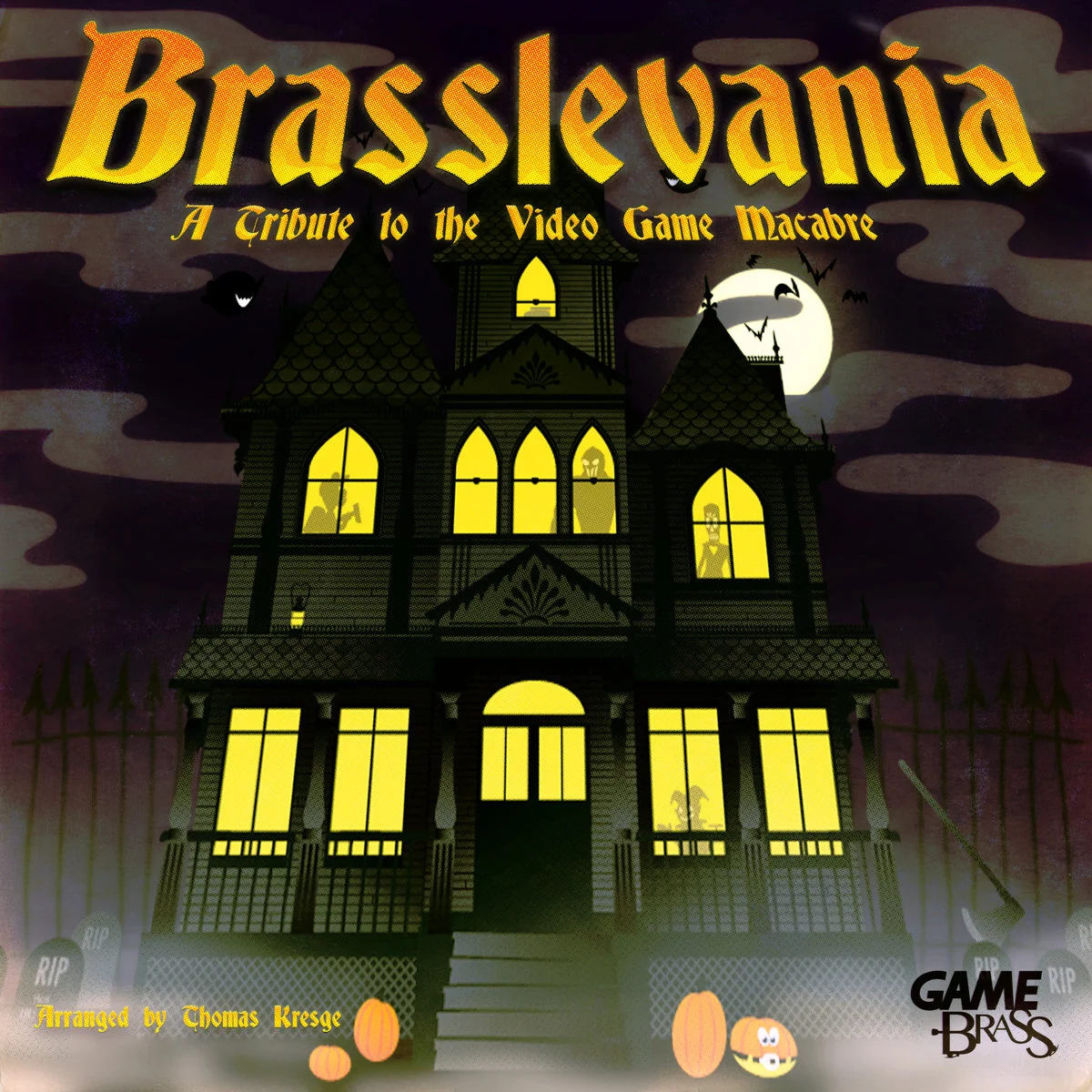Brasslevania Interview: The Video Game Macabre
The Game Brass
Brass quintet, The Game Brass, caught the VGM world by storm with their winter-themed album Snowtopia which released at the end of 2018. For their follow-up album, they decided to expand their roster and pay tribute to the video game macabre with Brasslevania. Album arranger Thomas Kresge and trombonist Daniel Romberger (album producer for Materia Collective’s EPOCH) share their thoughts on what made Brasslevania so spooktacular.
Was Brasslevania the logical choice after a holiday/winter-themed album?
Daniel Romberger: I'd say so! Snowtopia was very explicitly warm, cute, and wintry, whereas Brasslevania, being dedicated to scary music, can sometimes be very eerie and dissonant. Yet both of them have their seasonality. If we keep going with the "seasonal album every 9 months" approach, logically, you could expect to see a summer album in 2020 and a spring album in 2021 before Snowtopia 2 in winter of 2021. Not saying I can promise that though; we have other ideas and exciting plans in mind!
Thomas Kresge: Basically, yes. After doing Snowtopia, I thought a scary-season album would make a nice contrast. Also, it worked out well timeline-wise as it gave us some time to plan without waiting an entire year for a new album.
Snowtopia
Roughly, how long was the album in production?
Daniel Romberger: We recorded over most of the summer, but we’d been planning the concept since May—I personally did all of my Brasslevania parts at Robby's studio in July. Since there were 9 people (and a couple tracks that got added last-minute), we had to maintain a pretty tight schedule in order to finish mixing and mastering around the end of the summer.
Thomas Kresge: According to my file info, I made a folder for this project in November of 2018, but the first arrangement, “Mad Monster Mansion”, was finished sometime near the end of May, and June 2019 is really when we started seriously working on this. So, the album took about four months or so to produce. The players began recording near the end of June, and I finished the last arrangement on July 26th. Throughout August, I was mixing the album, but the last part didn’t actually get recorded until September 8th.
How did the tracklist come about? Were there any games that you wanted to include, but couldn't for some reason?
Daniel Romberger: We keep a spreadsheet of ideas for good pieces to arrange and have them categorized by theme. When Thomas came to us with the idea for Brasslevania, we already had about 20 or so scary tracks listed, many of which he chose though he also added some of his own. Then, as the arranging and recording processes were actually happening, many of us in the group had ideas for other tracks that we really wanted to see included (I pushed hard for "Life Is Beautiful," Danny Flam for "Transylvania," John Robert for the Grim Fandango Suite, etc.) and Thomas accommodated that. Ultimately, the project ended up being way bigger than we had initially envisioned but I think it turned out all the better for that!
Thomas Kresge: The Game Brass keeps a master spreadsheet of arrangement ideas, and I have my own list. The original concept I had in mind for the album was for things to be really dark and to lean into the horror elements. I was actively trying to avoid there being too much of the more upbeat, “silly” ghost music. So, the initial track list had a few more scary pieces that were ultimately cut, including pieces from Dead Space, Ni no Kuni, and Majora’s Mask. The tracklist eventually morphed into allowing more upbeat tracks. “Luigi’s Mansion”, “Life is Beautiful”, “World Revolving”, “Voyager”, “Transylvania”, and the Grim Fandango suite were all pieces added sometime in the middle of the project, mostly by special request of other band members.
In general, my only real goal when arranging is to make the music sound like a complete work for the intended ensemble.
Thomas, what was your biggest goal when it came to arrangements? What were the biggest challenges that you faced with the arrangements?
Thomas Kresge: The goals shifted, since at first I was trying to write things as “dark” as possible. This really influenced the first few arrangements, like “Mad Monster Mansion”, which would likely have come out way different if I had done it later.
In general, my only real goal when arranging is to make the music sound like a complete work for the intended ensemble. That is, it should stand on its own as a piece of music that someone can enjoy alongside more legit repertoire, even if they don’t know the source material. I try to balance keeping it in the spirit of the original track without simply re-orchestrating the original without alteration. I don’t often like to move too far away from the original, which I think kind of alienates fans of the music, but if it’s too similar then the arrangement doesn’t really have a reason to exist. Otherwise, I like to avoid repeating the same thing twice in a single arrangement, and I make sure I’m developing the material in a way that doesn’t get boring. To this end, “Ghost House”, “Big Boo’s Haunt”, and “Bloody Tears” were probably the hardest arrangements to do as they offered the least to work with.
How did you decide on collaborators? Were these all friends and colleagues of yours?
Daniel Romberger: We had a discussion very early on about expanding the ensemble for Brasslevania and ultimately settled on nine musicians. From there, it was all about reaching out to our brass friends who play those instruments. Marc Papeghin was the horn player on our very first track as The Game Brass, we met Ken HatVGM Crouch at MAGFest, we knew Jordan Moore from his channel and Ocabanda (and knew that he was a horn player), and John Stacy has kinda become our 6th member who played with us at MAGFest, rotating in and out. Having three horn friends in the expanded ensemble also freed Danny Flam up to play trombone, which is his primary instrument, since he usually plays horn in the quintet.
Describe the recording process. I assume that you all had to record your parts separately.
Thomas Kresge: Every part is recorded remotely, in isolation. I create a demo of the piece (a click track to help keep time) as well as a MIDI file so everyone can record more or less in sync. I then get the recordings from the band members and clean them up a bit to remove any extra room noise or other sounds that may have gotten in the recording, which helps blend everybody together as if all of the players are in the same space. A bit of post-editing is often required when mixing to make sure everyone lines up correctly, as differences in peoples’ recording setups, latency, and just the fact they are playing alone without any other players to breath with means some editing is almost always required when recording this number of players in isolation.
Could each of you pick your favorite track from the album and give an explanation as to why it's your favorite?
Daniel Romberger: Mine is “Life Is Beautiful”! As the tracklist was coming together, I noticed that there was basically nothing in a major key, and I thought it would be nice to have something lighthearted to contrast with the scary and emotionally intense arrangements on the album. “Life Is Beautiful” fits perfectly, since it's an absurdly catchy major key theme that plays in the horror game Deadly Premonition during numerous cutscenes, some of which are very grotesque, awkward, or morbid. It was a delight to get to whistle this tune and take a solo, and Thomas paid considerable attention to detail in orchestrating the brass parts.
Thomas Kresge: I don’t really have a favorite, but I do think the Resident Evil 2 track, “Secure Place”, came out much better than I was expecting. I feel I struggle to write interesting “quiet” music for brass. If I had to pick another favorite, it might be “Transylvania” from DuckTales.
How did the Grim Fandango Suite come about?
Daniel Romberger: Grim Fandango was the last piece that was added, by the insistence of John Robert Matz. We couldn't settle on which piece from the game to include, so it ended up morphing into a five-movement suite. Since Grim Fandango has connections to Day of the Dead, we wanted to make sure that we were treating the source material with respect so we reached out to Mariachi Entertainment System who agreed to collaborate with us (despite the tight timeline)! Mariachi Entertainment System truly added that extra flair that makes the track special, and it was an honor getting to work with them after being familiar with each other's work.
Who did the mixing and mastering for the album?
Thomas Kresge: I mixed the entire album over the course of about 6 weeks, and then Robby Duguay mastered everything in about a week.
I really enjoyed the "Ghost House" ensemble video. Who did the editing for that? It must have been a big task.
Daniel Romberger: Robby Duguay does almost all of The Game Brass's video editing through After Effects! It was pretty intense with all the semi-translucent ghosts flying around. In order to add that extra eerie touch for the video, we all recorded to a slowed down version of the track (half it's original tempo). Then, each person's individual video was played back at double speed, which causes all of those unsettling jerky effects!
Are you all pleased with the reaction to the album?
Daniel Romberger: Absolutely! When we had the listening party, it was awesome to see so many people (most of whom I didn't know) chatting, hanging out, and even purchasing the album! This was super energizing and encouraging. We also had a tweet that happened to go semi-viral around the time of the release, and that brought a ton of new followers to the channel, some of whom even purchased the album! It makes us happy to see that a lot of people who are interested in The Game Brass come from not only the video game music-loving world but also the world of classical music. It means a lot that HS and university students learning instruments get excited by what we do, even if they haven't played the games we cover or aren't even into games that much at all! There have even been university professors and professional ensembles who reached out!
It also means a lot to us that we've gotten a lot of positive feedback from other musicians in the VGM scene and people connected to the original game. Swery65, the creator of Deadly Premonition, saw our “Life Is Beautiful” video and shared it on Twitter and Facebook. Grant Kirkhope (the composer of Banjo-Kazooie, among other things) has been hugely supportive of what we do and tweeted about the album, and Jake Kaufman, who did the arrangements for DuckTales: Remastered, was very supportive as well.
Would you do anything differently if you had to do it all again?
Daniel Romberger: There was a considerable amount of stress that happened right before the initial release that resulted in us having to change distributors and resulted in our release to platforms other than Bandcamp to be delayed. Had we known about these issues sooner or worked with our current distributor from the onset, the delays likely would not have happened.
Thomas Kresge: There’s always improvements I have in mind for some of the administrative stuff of producing an album—how to deliver files, ensuring deadlines are met, making sure communication is open and consistent, etc. Nevertheless, the process of creating this album was relatively smooth. If I had to offer any advice to people, it’s to always have a backup plan for everything: musicians, arrangements, distributors, any of them can fall through, and it’s important to save yourself the stress of scrambling at the last minute.
As for the arrangements themselves, I’m proud that I was able to create an arrangement out of the very textural and atmospheric “Big Boo’s Haunt” track from Super Mario 64, but it’s also the track I’m probably most unhappy with overall. I have a lot of ideas for it that I think would have made a better arrangement, so I’d probably do that one differently if I had to do it again.
Who came up with the name "Brasslevania?"
Daniel Romberger: Brasslevania was actually originally Robby's name, I believe! We mentioned it in the description of one of our first-ever videos, an arrangement of “Dracula's Castle” from Symphony of the Night. Ultimately, we liked the name because it fits nicely alongside Snowtopia, referencing a place suffix (-vania) and having a connection to both video games (Castlevania) and the macabre.
Thomas Kresge: We brainstormed album names during a video chat, which included mixing different words for “brass” or “scary” with different words for a “place” (like -land, -topia, -ville, etc.). John Robert Matz ultimately came up with “Brasslevania”; however, Robby had used that word as a tag for a “Symphony of the Night” video the Game Brass had released over a year ago. Sadly, our first title, Bonetopia, didn’t receive the full group’s approval.
Purchase/Preview Brasslevania Today!
Album art by Scott Gamble


